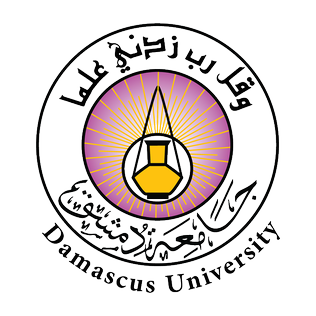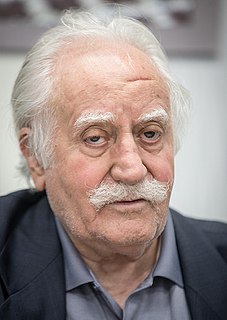
Arabic calligraphy is the artistic practice of handwriting and calligraphy based on the Arabic alphabet. It is known in Arabic as khatt, derived from the word 'line', 'design', or 'construction'. Kufic is the oldest form of the Arabic script.

Mahmoud Taha is a Jordanian artist, potter and ceramicist noted for integrating calligraphy into his ceramics and is regarded as the leading ceramicist in the Arab world.
Princess Wijdan Ali is a Jordanian artist, art historian, educator and diplomat. She is the ex-wife of Prince 'Ali bin Naif of Jordan. She is best known for her efforts to revive the traditions of Islamic art and her abstract paintings and for her work as an art historian.

The University of Damascus is the largest and oldest university in Syria, located in the capital Damascus and has campuses in other Syrian cities. It was founded in 1923 through the merger of the School of Medicine and the Institute of Law. Until 1958 it was named the Syrian University, but the name changed after the founding of the University of Aleppo. There are nine public universities and more than ten private ones in Syria. Damascus University was one of the most reputable universities in the Middle East before the war in Syria started in 2011.
Osman Waqialla, was a 20th century Sudanese painter and calligrapher, noted for his creative use of Arabic letter forms in his artworks, thereby integrating African and Islamic cultural traditions into the contemporary art of Sudan. This use of Arabic calligraphy as a modern, non-religious graphic form places Waquialla within the Arabic art movement that became known as the Hurufiyya movement.

Jordanian art has a very ancient history. Some of the earliest figurines, found at Aïn Ghazal, near Amman, have been dated to the Neolithic period. A distinct Jordanian aesthetic in art and architecture emerged as part of a broader Islamic art tradition which flourished from the 7th-century. Traditional art and craft is vested in material culture including mosaics, ceramics, weaving, silver work, music, glass-blowing and calligraphy. The rise of colonialism in North Africa and the Middle East, led to a dilution of traditional aesthetics. In the early 20th-century, following the creation of the independent nation of Jordan, a contemporary Jordanian art movement emerged and began to search for a distinctly Jordanian art aesthetic that combined both tradition and contemporary art forms.

Wahbi al-Hariri-Rifai Arabic: وهبي الحريري آلرفاعي was a Syrian American artist who has often been called "the last of the classicists". As an artist he was remarkably prolific in the last years of his life despite a protracted and painful struggle with terminal cancer. He was also an accomplished architect, archaeologist, and author. His artwork has garnered international recognition and praise both in his lifetime and posthumously.
Nazir Nabaa was a Syrian painter. Considered a pioneer of modern Syrian art, he studied art in Cairo from 1959 to 1965, and continued his training at École nationale supérieure des Beaux-Arts in Paris from 1971 to 1974. After completing his studies he returned to Damascus and joined the faculty of the College of Fine Arts at Damascus University. Nabaa's style is noted for blending together ancient visual culture with modern themes, and his work has been shown in exhibitions at museums such as the Jordan National Gallery of Fine Arts.

Mahmoud Farshchian is a master of Persian painting (Miniature) miniatures. He was born in the city of Isfahan in Iran, and it was here where he learned art, painting, and sculpting.
Mamoun Sakkal is a Syrian type designer, artist and calligrapher.

Roland Khoury (1930—1988) was a Syrian painter.

Shakir Hassan Al Said (1925–2004), an Iraqi painter, sculptor and writer, is considered one of Iraq's most innovative and influential artists. An artist, philosopher, art critic and art historian, he was actively involved in the formation of two important art groups that influenced the direction of post-colonial art in Iraq. He, and the art groups in which he was involved, shaped the modern Iraqi art movement and bridged the gap between modernity and heritage. His theories charted a new Arabic art aesthetic which allowed for valuations of regional art through lenses that were uniquely Arabic rather than Western.
Nja Mahdaoui, is a Tunisian artist known for his use of calligraphy as a graphic art form. He has often been described as a ‘choreographer of letters.'
Madiha Umar (1908 – 2005 in Aleppo) is an Iraqi artist who is known for incorporating calligraphy with abstract art. She is generally perceived as the first Arab artist to have done this. Therefore, she is seen as the precursor to the Hurufiyya movement. Also, Umar was the first female to receive a scholarship from the Iraqi government to study in Europe. Today her grandson Dara Kittani manages her Estate Collection. To see more about Madiha Umar go to her official website www.madihaumar.com
Derrie Fakhoury (1930–2015) was a Lebanese artist.
Nihad Nadam is a Syrian digital artist based in Dubai, United Arab Emirates. Nihad Nadam was born in Damascus in 1977. It was during his youth, immersed in the ancient culture and heritage of his homeland, that he developed a passion for Arabic culture and Arabic calligraphy. He studied fine art at the Adham Ismael Institute of Fine Art in Damascus and multimedia design at the American University of Sharjah in the UAE. He has been based in Dubai since 1999.
Ib Benoh is a multidisciplinary artist, painter, sculptor, poet, and scholar. Benoh lives and works in Washington, DC.
The Hurufiyya movement is an aesthetic movement that emerged in the second half of the twentieth century amongst Arab artists, who used their understanding of traditional Islamic calligraphy within the precepts of modern art. By combining tradition and modernity, these artists worked towards developing a culture specific visual language, which instilled a sense of national identity in their respective nation states, at a time when many of these states where shaking off colonial rule and asserting their independence. They adopted the same name as the Hurufi, an approach of Sufism which emerged in the late 14th–early 15th century. Art historian Sandra Dagher has described Hurufiyya as the most important movement to emerge in Arabic art in the 20th century.

Mahmoud Jalal, , was a Libyan-born Syrian artist, painter, sculptor, medalist, and one of the early leaders of the modern art movement in Syria.
Renato Barisani was an Italian sculptor and painter.











